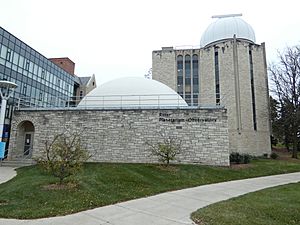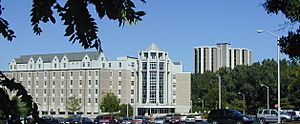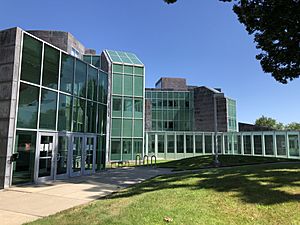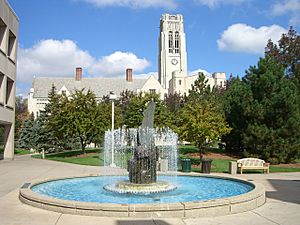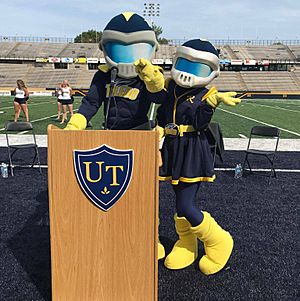University of Toledo facts for kids
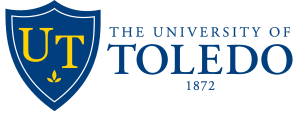 |
|
|
Former name
|
Toledo University of Arts & Trades (1872–1884) Toledo Manual Training School (1884–1914) Toledo University (1914–1967) |
|---|---|
| Motto | Coadyuvando El Presente, Formando El Porvenir |
|
Motto in English
|
Guide to the Present, Moulder of the Future |
| Type | Public research university |
| Established | October 12, 1872 |
|
Parent institution
|
University System of Ohio |
| Accreditation | HLC |
|
Academic affiliations
|
|
| Endowment | $625.1 million (2024) |
| President | James Holloway |
| Provost | Scott Molitor (interim) |
|
Academic staff
|
2,232 |
| Students | 14,440 |
| Undergraduates | 11,036 |
| Postgraduates | 3,404 |
| Location |
,
,
United States
|
| Campus | Urban Main, 813 acres (329 ha) Health Science, 450 acres (180 ha) Scott Park, 160 acres (65 ha) |
| Newspaper | The Collegian |
| Colors | Midnight blue and gold |
| Nickname | Rockets |
|
Sporting affiliations
|
NCAA Division I FBS – MAC |
| Mascot | Rocky the Rocket & Rocksy the Rockette |
The University of Toledo (often called UToledo or UT) is a large public university in Toledo, Ohio. It is a place where students can learn and do important research. The university has a main campus and a Health Science campus. The Health Science campus includes the University of Toledo Medical Center. There is also a Center for the Visual Arts in downtown Toledo. A special research center, the Lake Erie Center, is located at Maumee Bay State Park.
The university started in 1872 as a private school. It was first called the Toledo University of Arts and Trades. After a few years, it closed down. The city of Toledo took over the school in 1884. It reopened as the Toledo Manual Training School. Over time, it grew from a trade school into a full university.
In 1931, the university moved to its current main campus. Since then, it has grown a lot. It now has more than 100 buildings. The university is known for its strong programs in science, engineering, and medicine. It is a top university for research.
The University of Toledo has over 100,000 former students. More than 13,000 students attend the university today. There are over 300 student clubs and groups. The university's sports teams are called the Rockets. They play in the Mid-American Conference.
Contents
History of UToledo
How UToledo Started
The University of Toledo began in 1872. It was a private school for arts and trades. Students learned things like painting and architectural drawing. A local newspaper editor, Jesup Wakeman Scott, believed Toledo would become a very important city. He gave 160 acres of land to start a university. The school's first goal was to help artists and craftspeople learn more. Scott passed away in 1874, and the university opened in an old church building in downtown Toledo a year later.
By the late 1870s, the school had money problems and closed in 1878. On January 8, 1884, the city of Toledo took over the school. It reopened as the Toledo Manual Training School. This school offered a three-year program. Students who were at least 13 years old learned both school subjects and trade skills.
Growing in the 1900s
Jerome Raymond became the university's first president in the early 1900s. He added more programs. The school worked with the Toledo Conservatory of Music and the YMCA College of Law. He also started the College of Arts and Sciences. Even with these changes, the school faced money problems.
A. Monroe Stowe became president in 1914. He helped organize the college. On January 30, 1914, the school became known as Toledo University. Stowe added more colleges, like the College of Commerce and Industry in 1914. He also started the College of Education in 1916. During this time, the number of students grew from 200 to about 1,500.
As the school grew, so did student activities. The first college sports teams started in 1915. Football was added in 1917. Students also formed a student council and a newspaper. The sports teams got their nickname, the Rockets, in 1923. A newspaper writer thought the name showed how fast and exciting the teams played.
By the 1920s, Toledo University was getting too big for its buildings. Classes were held in two small buildings downtown. In 1922, the university moved to a larger building. This building was originally for training soldiers during World War I.
Even the new location quickly became too small. Student numbers increased by 32 percent. In 1928, Henry J. Doermann became president. He planned a new campus. The city approved money for the new campus. Doermann worked with architects to design the buildings. They used styles from European universities. They hoped the beautiful buildings would inspire students. University Hall and the Field House were finished in the Collegiate Gothic style.
During the Great Depression, student numbers stayed steady. Philip C. Nash became president after Doermann. He cut costs and used money from President Franklin D. Roosevelt's programs. This money helped pay for new buildings and scholarships.
UToledo During World War II
When the United States entered World War II, the university changed a lot. The military hired the university to offer training programs. These programs were for both soldiers and civilians. Civilians could take classes in engineering, science, and management. They could also learn to fly planes.
The military used the university to train soldiers from the United States Army Air Corps. The U.S. Cadet Nurse Corps trained nurses for army hospitals. More women attended the university during the war. Student groups also changed. For example, intercollegiate basketball and football stopped. The university's Red Cross chapter held knitting sessions. Students made sweaters for soldiers.
After the war, the GI Bill of Rights helped veterans pay for college. Over 3,000 veterans used this program at UT. In 1945, the university bought military housing. It moved the housing to campus for veterans. This area was called "Nashville." It became housing for married students until 1974.
In 1947, Wilbur W. White became president. He planned a ten-year growth plan. He passed away in 1950. The next president, Dr. Asa Knowles, continued the plan. A new men's dormitory was finished in 1952. A new library was completed in 1953. The university also expanded programs for adult students. It used television for educational purposes.
In 1958, the university needed more money. It asked the state of Ohio for help. The city of Toledo had been paying for the university. This was becoming too expensive for the city.
Asa Knowles left that year. William S. Carlson continued to ask the state for help. In 1959, bills were introduced to help the three largest city universities in Ohio. These were the University of Toledo, the University of Akron, and the University of Cincinnati. The bills did not pass right away. But a special tax was approved to help the university. Finally, on July 1, 1967, the university became a state university. This meant the state of Ohio would help pay for it. The university then changed its name to the University of Toledo.
The 1960s saw more student activities on campus. Students protested about different issues. There was a peaceful protest about food quality in 1968. Students also protested the Vietnam War. In 1970, UT students stayed peaceful after the Kent State shootings. A protest by African American students in May 1970 also ended peacefully. The university president met with the students.
UT celebrated its 100th birthday in 1972. President Carlson retired. Glen R. Driscoll became the new president. He continued to expand the university. New buildings like the Center for Performing Arts and Centennial Hall were added. Centennial Hall was later renamed John F. Savage Arena. The university also created Centennial Mall. This was a nine-acre park in the middle of campus.
Frank E. Horton became president in 1988. He continued the university's growth. He started a big plan for the university's future. In 1993, the university started a $40 million fundraising campaign. In the mid-1990s, UT updated buildings for classrooms. A new Academic Center and Residence Hall was built in 1992. The Center for the Visual Arts at the Toledo Museum of Art was also finished that year. The International House Residence Hall and Nitschke Hall were built in 1995. Construction began on a Pharmacy, Chemistry and Life Sciences complex. A Lake Erie Research Center was also started at Maumee Bay State Park. The 1990s also brought big changes in technology. The university joined OhioLINK, a library network. Computer labs and internet access were added in dorms and offices. The university also created its first website.
UToledo in the 2000s
On March 31, 2006, Governor Bob Taft signed a bill. This bill combined the University of Toledo with the Medical University of Ohio. The two universities officially merged on July 1, 2006. The combined school kept the name University of Toledo. The former Medical University of Ohio facilities became the Health Science Campus.
This merger made Toledo the third largest public university in Ohio. It also became one of only 17 public universities in the country that has colleges for business, education, engineering, law, medicine, and pharmacy. The College of Pharmacy is now one of only 45 in the U.S. that is part of a larger health science center. This merger created more learning and research chances for students and teachers. What used to be one College of Arts and Sciences was divided into three new colleges.
What Students Learn
The University of Toledo offers over 250 different study programs. It is the sixth largest university in Ohio by student numbers. There are about 20 students for every teacher. The average class size is 25 students.
Students can join national honor societies like Phi Kappa Phi. The university also offers special ways to make learning better. These include the Honors College, studying abroad, and joining various clubs. Students can also do their own research projects.
The University of Toledo is a public university. It is managed by a board of trustees. These members are chosen by the Governor of Ohio. The board has 9 members and 2 student members. They are unpaid community members. They give power to the president to run the university. The current interim president is Matthew Schroeder.
The University of Toledo has many different colleges:
- College of Arts and Letters
- John B. and Lilian E. Neff College of Business and Innovation
- Judith Herb College of Education
- College of Engineering
- College of Health and Human Services
- College of Graduate Studies
- College of Law
- College of Medicine and Life Sciences
- College of Natural Sciences and Mathematics
- College of Nursing
- College of Pharmacy and Pharmaceutical Science
- University College
Research at UToledo
The university has a special group called the University of Toledo Research Enterprise. It also has many research centers.
The Lake Erie Center is located at Maumee Bay State Park. It studies environmental problems that affect the Great Lakes.
The UT Polymer Institute is part of the College of Engineering. It studies polymers and plastic technology.
The Wright Center for Photovoltaics Innovation and Commercialization (PVIC) started in 2007. It received a large grant to do research on clean electricity. This center works on making solar technologies better. They want to make solar panels more efficient and cheaper to produce. This will help more homes and businesses use solar power. The main locations for this research are the University of Toledo, Ohio State University, and Bowling Green State University.
In 2012, the University of Toledo became a partner in the Lowell Discovery Telescope. This is a large telescope used for astronomy research.
Student Life
| Race and ethnicity | Total | ||
|---|---|---|---|
| White | 69% |
|
|
| Black | 10% |
|
|
| Other | 7% |
|
|
| Hispanic | 5% |
|
|
| Foreign national | 5% |
|
|
| Asian | 2% |
|
|
| Economic diversity | |||
| Low-income | 34% |
|
|
| Affluent | 66% |
|
|
Sports at UToledo
The University of Toledo's sports teams are called the Rockets. Their team colors are midnight blue and gold. The Rockets play in the Mid-American Conference. The football team has won eleven Mid-American Conference championships. These wins happened in 1967, 1969, 1970, 1971, 1981, 1984, 1990, 1995, 2001, 2004, 2017, and 2022.
Toledo Rockets football played in the 2010 Little Caesars Pizza Bowl. They lost to Florida International 34–32. Toledo also played in the 2015 Go Daddy Bowl against Arkansas State. The Rockets won that game 63–44.
In 2009, the men's tennis team finished second in their regular season. They reached the finals of the MAC tournament for the first time in 35 years.
The Toledo Rockets men's basketball team won the Mid-American Conference championship in 2006–07. The team has also received awards for high academic performance. Their academic rating was tied for third best among all NCAA Division I men's basketball programs.
In Spring 2011, the University of Toledo women's basketball team won the WNIT. This made them the first MAC team in any sport to win a National Championship in modern times.
The women's cross country team has won four MAC Championships. These were in 2001, 2002, 2010, and 2011. They also finished second three times. The women's cross country team finished 21st at the NCAA Championships in 2011. They finished 28th at the NCAA Championships in 2010. The women's track team also finished second in the 2012 MAC Indoor and Outdoor championships.
The University of Toledo has two official mascots: Rocky the Rocket and Rocksy the Rockette. Rocky was introduced in 1966, and Rocksy joined in 2011. UT also has a spirit crew called Blue Crew. The University of Toledo Rocket Marching Band performs at all home football games in the Glass Bowl.
Rivalry with Bowling Green
Toledo's main football rivals are the Falcons from Bowling Green State University. The two teams used to play for a trophy called the Peace Pipe. This trophy started with basketball but moved to football in 1980. Now, the teams play for the "Battle of I-75" trophy. This is a bronze trophy given to the winner of the game. Toledo currently leads the series. Toledo has won 10 out of the last eleven games. This includes a big 66–37 win at Bowling Green's home field.
Club Sports
The University of Toledo also has many club sports. These are run by the university's Division of Student Affairs. Club sports get some money from the university. Students also pay dues and do fundraising to cover costs. Club sports at UT include: football, bowling, women's basketball, crew, cross country, men's ice hockey, men's and women's lacrosse, quidditch, sailing, men's soccer, table tennis, tennis, track and field, men's and women's ultimate disc, fencing, men's and women's volleyball, water polo, and wrestling.
Some recent achievements of UT Sport Clubs include three wrestling national championships from 2006 to 2008. The sailing team won three Midwest-Collegiate Sailing Association Championships. They also appeared in two Inter-Collegiate Sailing Association National Championships. The men's soccer club won a national championship in 1996. The men's ice hockey team won an ACHA Division I National Championship in 1992.
Ice Hockey
The Toledo Rockets men's ice hockey team is part of the American Collegiate Hockey Association (ACHA) Division I. The team is also a founding member of the Tri-State Collegiate Hockey League (TSCHL), which started in 2010. The team plays 30–35 games each season against other club teams in the area.
Famous People from UToledo
See also
 In Spanish: Universidad de Toledo para niños
In Spanish: Universidad de Toledo para niños



